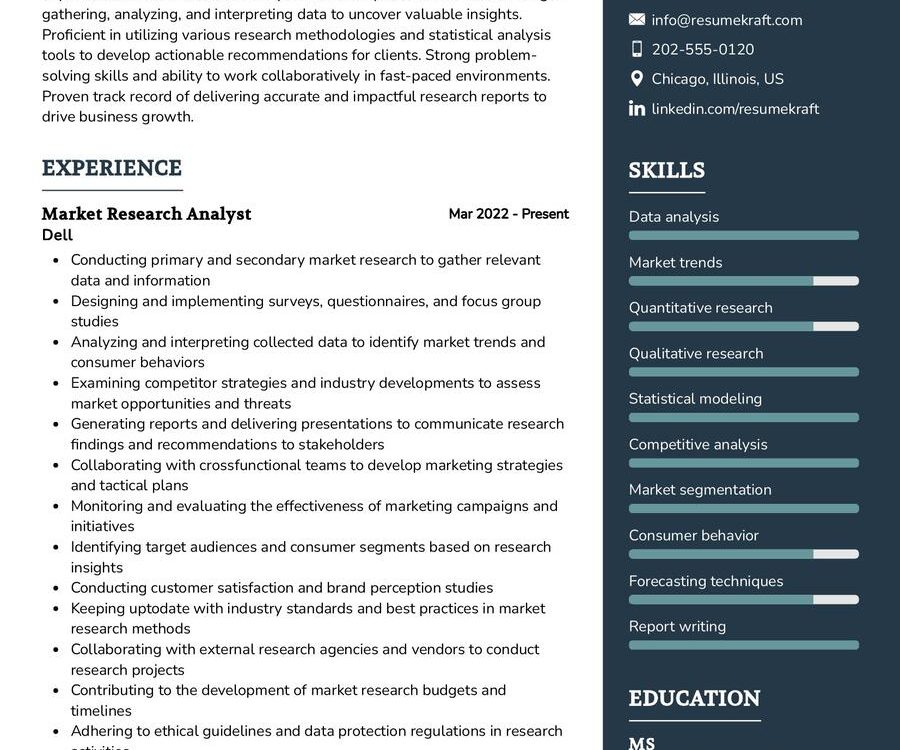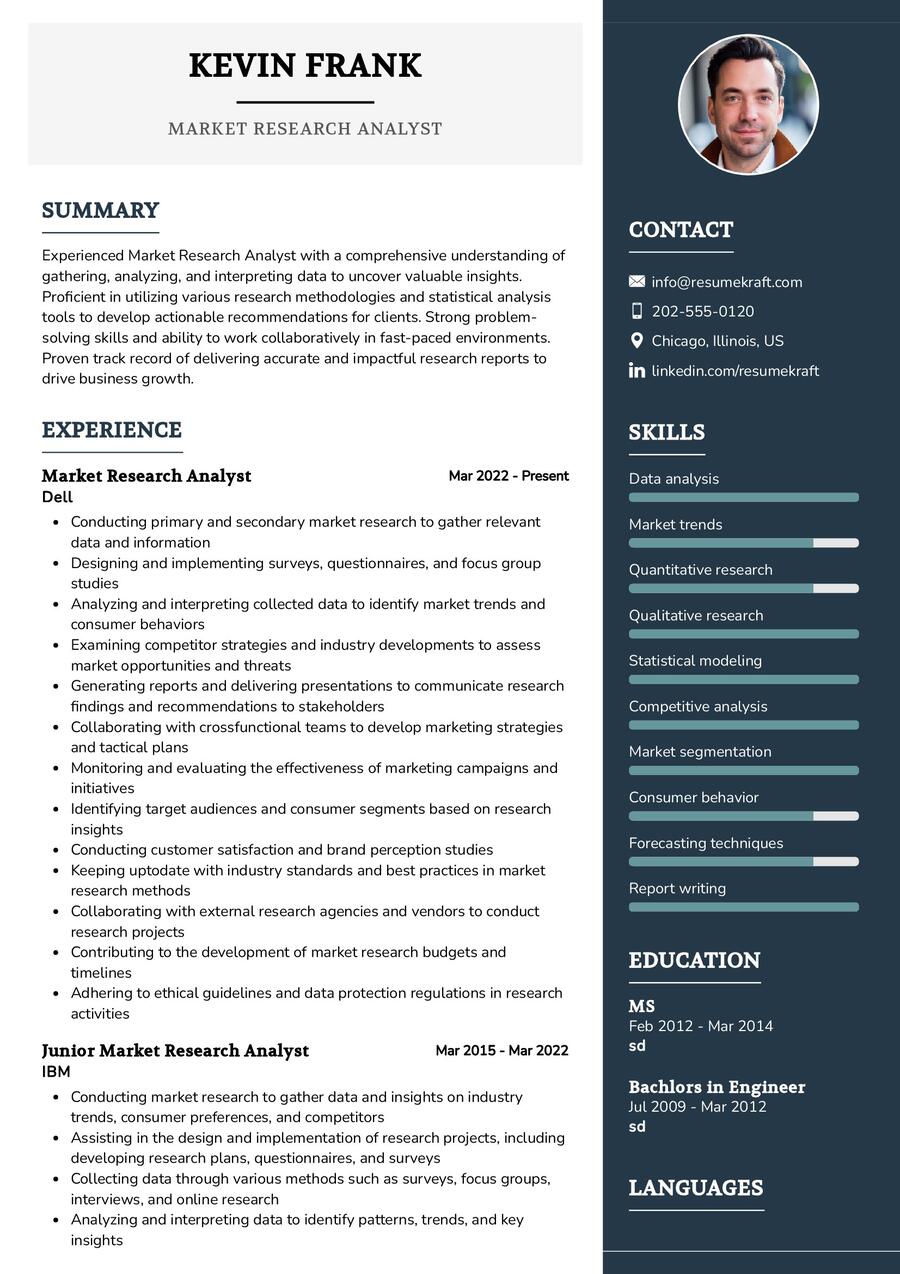Exploring the Role of a Market Research Analyst
As businesses navigate the ever-changing market landscape, the role of a Market Research Analyst has become integral to informed decision-making. This position requires a unique blend of analytical prowess, strategic thinking, and a deep understanding of market dynamics. In this article, we’ll delve into the multifaceted responsibilities of a Market Research Analyst, the essential job requirements, and tips on crafting a compelling resume for this dynamic role.
Market Research Analyst Job Requirements
Stepping into the shoes of a Market Research Analyst involves meeting specific criteria that ensure proficiency in navigating the complex world of market analysis. Let’s explore the key requirements for this role:
- A Bachelor’s or Master’s degree in Marketing, Business, Statistics, or a related field, demonstrating a solid foundation in analytical disciplines.
- Proficiency in statistical analysis tools and market research software, showcasing the ability to derive meaningful insights from data.
- Experience in quantitative and qualitative research methods, illustrating a well-rounded approach to gathering information.
- Excellent communication skills, both written and verbal, to convey complex findings in a clear and understandable manner.
- Strong attention to detail, a crucial skill for accurate data interpretation and reporting.
- Adaptability to evolving market trends and the ability to think critically in dynamic situations.
Additionally, obtaining certifications in market research methodologies can elevate your profile in the competitive job market.
Responsibilities of a Market Research Analyst
The role of a Market Research Analyst involves wearing multiple hats, from conducting market surveys to interpreting data for strategic decision-making. Here are the key responsibilities that define this dynamic position:
- Designing and implementing market research projects to gather relevant data for business strategies.
- Conducting competitor analysis to identify market trends and opportunities.
- Analyzing consumer behavior, preferences, and buying patterns to provide insights for product development and marketing campaigns.
- Preparing comprehensive reports and presentations for stakeholders, translating complex data into actionable recommendations.
- Collaborating with cross-functional teams to align research findings with overall business goals.
- Staying abreast of industry trends and market developments to inform strategic decision-making.
- Utilizing both qualitative and quantitative research methods to ensure a holistic understanding of the market.
Each responsibility is a crucial thread in the fabric of informed decision-making that drives business success.
Crafting a Standout Market Research Analyst Resume
Your resume is your gateway to landing that coveted Market Research Analyst position. To ensure it stands out, consider the following tips:
- Highlight specific research projects you’ve led, emphasizing the impact they had on business outcomes.
- Showcase your proficiency in using market research tools and statistical analysis software.
- Quantify your achievements with metrics, providing tangible evidence of your contributions.
- Customize your resume for each application, tailoring your skills and experiences to match the job description.
Remember, your resume is not just a document; it’s a narrative of your expertise in driving business success through effective market analysis.
Market Research Analyst Resume Summary Examples
Your resume summary is the opening act of your career story. Craft a powerful snapshot of your skills and experiences with examples like:
- “Results-driven Market Research Analyst with a track record of delivering actionable insights, driving a 15% increase in product sales.”
- “Experienced Analyst skilled in utilizing advanced statistical techniques to uncover market trends, contributing to the successful launch of three new product lines.”
- “Detail-oriented Research Analyst with expertise in both qualitative and quantitative research, providing strategic recommendations that led to enhanced market positioning.”
Your summary should entice potential employers to delve deeper into your resume, eager to explore the value you bring to the table.
Experience Section for Your Market Research Analyst Resume
Your experience section is the heart of your resume, showcasing the depth of your expertise. Provide detailed examples such as:
- “Led a cross-functional team in conducting a comprehensive market analysis, resulting in a strategic repositioning that increased market share by 10%.”
- “Executed a customer satisfaction survey, identifying pain points and implementing solutions that led to a 20% improvement in overall customer satisfaction.”
- “Developed and implemented data collection methodologies, streamlining the research process and reducing project completion time by 15%.”
Each experience is a testament to your ability to turn data into actionable insights that drive business success.
Education Section for Your Market Research Analyst Resume
Your educational background is a crucial component of your resume. Highlight your academic achievements like:
- Master of Business Administration in Marketing, XYZ University, 2019.
- Bachelor of Science in Statistics, ABC University, 2017.
- Certified Market Research Professional (CMRP), Market Research Society, 2020.
Your education showcases the foundation of your analytical skills and your commitment to staying current in the field.
Market Research Analyst Skills for Your Resume
Your skill set is your toolkit, equipped with the abilities that set you apart as a Market Research Analyst. Showcase your skills in:
Soft Skills:
- Analytical thinking and attention to detail, ensuring accurate interpretation of complex data.
- Effective communication, conveying insights in a clear and understandable manner.
- Strategic thinking, linking research findings to overarching business objectives.
- Adaptability, staying agile in a dynamic market environment.
- Team collaboration, working seamlessly with cross-functional teams.
Hard Skills:
- Proficiency in statistical analysis tools (e.g., SPSS, R) and market research software.
- Quantitative and qualitative research methods, ensuring a comprehensive understanding of market dynamics.
- Data visualization, translating complex data into clear and impactful presentations.
- Competitor analysis, identifying market trends and opportunities.
- Report writing, presenting findings in a structured and compelling manner.
Each skill is a tool in your arsenal, demonstrating your ability to navigate the complexities of market analysis.
Common Mistakes to Avoid in Your Market Research Analyst Resume
Ensure your resume avoids common pitfalls that can hinder your chances of landing your dream Market Research Analyst position. Steer clear of mistakes such as:
- Using generic language, failing to highlight your unique strengths and experiences.
- Focusing solely on duties rather than accomplishments, providing a superficial view of your capabilities.
- Neglecting a cover letter, missing an opportunity to add a personal touch to your application.
- Overloading your resume with technical jargon, potentially alienating non-technical readers.
- Skipping proofreading, risking a negative impression with spelling or grammatical errors.
Avoiding these mistakes ensures your resume is a polished representation of your skills and experiences.
Key Takeaways for Your Market Research Analyst Resume
As you craft your Market Research Analyst resume, keep these key points in mind:
- Emphasize your impact, showcasing how your analyses have driven positive business outcomes.
- Demonstrate your technical proficiency in using market research tools and statistical analysis software.
- Highlight strategic initiatives you’ve spearheaded, connecting research findings to broader business objectives.
- Include a section on continuous learning, demonstrating certifications and courses that enhance your market research skills.
Finally, feel free to utilize resources like AI Resume Builder, Resume Design, Resume Samples, Resume Examples, <a href


